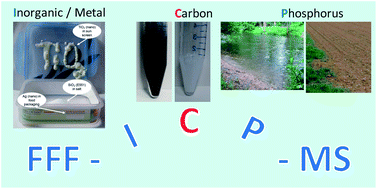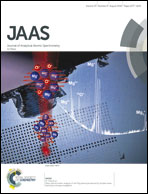Extending the capabilities of field flow fractionation online with ICP-MS for the determination of particulate carbon in latex and charcoal†
Abstract
There is a broad range of carbon based engineered particles including polymer latex particles and carbon black. Also in environmental systems particulate carbon such as humic acids and soot or coal (the latter two summarized as black carbon) is of great importance and is involved in nutrient storage and (re)cycling. Therefore, detailed characterisation of the size distribution and elemental composition of such particles is required to understand the material properties and their environmental relevance. Field flow fractionation (FFF) online with inductively coupled plasma mass spectrometry (ICP-MS) is routinely applied for the characterisation of metal containing particles. However, the far majority of FFF studies relies on UV detection for organic carbon while elemental detection of carbon has hardly been used. Our previous work demonstrated the capability of FFF-ICP-MS for the determination of carbon in fine particulate matter, focusing on humic acid in water samples. The current work investigates the feasibility of carbon detection and quantification in larger particles with sizes up to about 750 nm. For this purpose, latex particle size standards of 21 nm, 100 nm, 250 nm and 740 nm were analysed as well as extracts of charcoal spiked soil. Elemental analysis using combustion techniques was employed as reference for the total carbon content of the samples to establish a mass balance. Recoveries for FFF separation of latex particle standards were in the range from 69% to 83% and in the range from 78% to 104% in flow injection mode. Carbon mass balance calculated from FFF fractionation, ultrafiltration and total content for the extracts from soil and charcoal spiked soil achieved 76% to 105%. Variation of the sampling depth was investigated to check if increased dwell time of the particles in the plasma affects the carbon ionisation and quantification. No significant change of carbon recoveries was observed, yet the signal to noise ratio improved 3-fold. This study provides a method for the analyses of carbon containing particles via FFF-ICP-MS, which allows for the first time the simultaneous measurement of carbon and other nutrients and is hence more timesaving than other methods.



 Please wait while we load your content...
Please wait while we load your content...